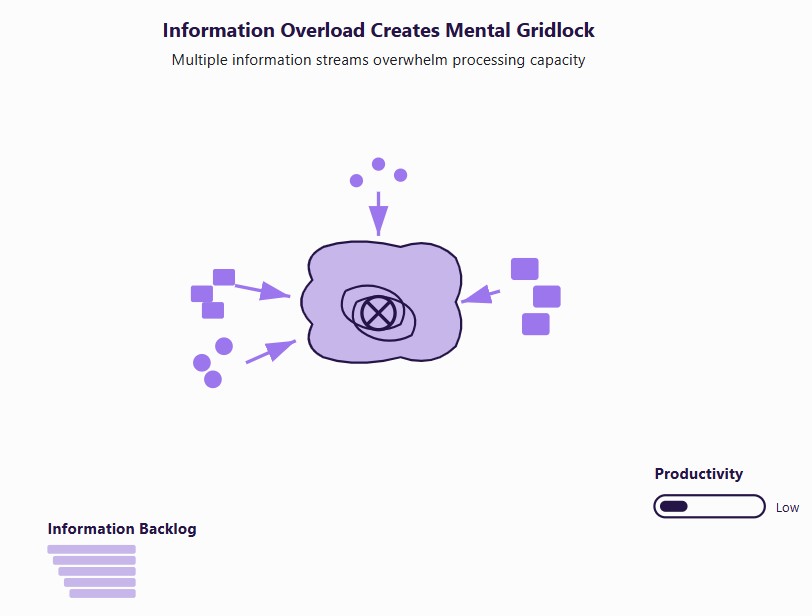Your team is running on updates, replies, and back-to-back check-ins - yet progress feels slower than ever. If that sounds familiar, it’s time to take a closer look at why overcommunication is hurting your project team more than helping it.
The signs aren’t always obvious, but the impact? Hard to ignore once it starts costing time, clarity, and trust.
In this article, we will:
- See how overcommunication slows projects down
- Spot the signs that your team is overcommunicating
- Apply proven strategies to fix communication overload
Too much talk, too little progress: How overcommunication derails projects
Overcommunication may seem like a sign of transparency and diligence - but beneath the surface, it’s silently eroding productivity, morale, and decision-making. Let’s break down why too much chatter is doing more harm than good.
The hidden costs of communication overload
When communication transforms from a bridge to a barrier, the consequences ripple through every aspect of project execution. Your team is drowning in information, and the impact goes far deeper than simple frustration.
Information paralysis: When updates become overwhelming
Teams become paralyzed by the sheer volume of information they receive daily. When everything is urgent, nothing is urgent, leading to misplaced priorities and missed deadlines.
- 47 unread emails before the first meeting starts
- Critical deadlines are buried under routine status updates
- Important decisions are delayed while sorting through information noise
- Team members spend 2+ hours daily just processing communications

Industry reality: According to McKinsey research, executives spend 28% of their waking hours reading and answering emails.
Decision-making delays: Too much input creates analysis paralysis
Excessive communication creates a false sense of democratic decision-making where teams feel obligated to wait for everyone's input. Research shows that teams with communication overload take 3x longer to make simple decisions compared to streamlined teams.
- 12 stakeholders weighing in on decisions that need 2-3 key people
- Simple approvals stretching from 1 day to 2 weeks
- Decision fatigue is setting in by midday
- Missed market opportunities while competitors move ahead
Pro tip: Implement the "RACI framework" (Responsible, Accountable, Consulted, Informed) for each decision. Only the "Responsible" and "Accountable" parties make the decision, while others are simply informed of the outcome.
Productivity decline: The interruption epidemic
Every interruption costs your team approximately 23 minutes to fully refocus on their original task. Modern project teams operate in "continuous partial attention" mode, never fully focused on any single task.
- 15+ daily interruptions are stealing 2.5-8 hours of productive work time
- Decreased work quality due to scattered attention
- Higher error rates require expensive rework
- Increased stress levels from constant context switching
Study findings: University of California, Irvine research by Dr. Gloria Mark showed that after an interruption, it takes an average of 23 minutes and 15 seconds to fully refocus on the original task.
The psychology behind communication fatigue
Understanding why overcommunication hurts requires diving into the psychological and neurological impacts on your team members. The human brain isn't designed to handle the constant communication demands of modern project work.
Cognitive overload: Your brain's bandwidth limitation
The human brain has a finite capacity for processing information, much like a computer's RAM. Modern knowledge workers operate at 95% of their cognitive capacity during a typical workday, leaving little room for creative thinking.
- Decision fatigue by midday, even on simple choices
- Reduced creative thinking and problem-solving ability
- Memory problems retaining important project information
- Emotional exhaustion leading to team conflict
Warning signs: If your team struggles to remember decisions made in yesterday's meeting or seems irritable during afternoon sessions, they're likely experiencing cognitive overload.
Context switching costs: The hidden time thief
Every communication channel switch costs 11-32 minutes of reduced productivity. Team members lose valuable focus time transitioning between emails, Slack, meetings, and actual project work.
- 1-2 minutes disengaging from the current task
- 2-5 minutes reorienting to new communication
- 3-10 minutes processing new information
- 5-15 minutes re-engaging with original work
Quick fix: Batch similar communications together. Check emails only at designated times (9 AM, 1 PM, 5 PM) rather than responding immediately to each notification.
Meeting recovery syndrome: The exhaustion that follows
Meeting Recovery Syndrome (MRS) causes significant fatigue and productivity decline after meetings. Team members need 15-45 minutes to fully recover their focus after typical meetings, with virtual meetings creating even more cognitive drain.
- Mental exhaustion even after 30-minute meetings
- Difficulty concentrating on subsequent tasks
- Physical fatigue from prolonged screen time
- Reduced problem-solving ability for hours afterward
Game-changer: Schedule meetings to end 5-10 minutes early and build in recovery time. A team that implemented "50-minute meetings" instead of hour-long sessions saw 25% improvement in afternoon productivity scores.
Overcommunication is a systematic assault on your team's cognitive resources. Recognizing these hidden costs is the first step toward building a communication culture that serves your project's success rather than sabotaging it.
Is your team talking too much? Here’s how to diagnose overcommunication fast
Overcommunication doesn’t always scream for attention. It quietly creeps into your workflow, disguised as alignment, transparency, or diligence - until productivity plummets, decisions stall, and your team burns out.
If you suspect your team is stuck in a cycle of communication overload, it’s time for a quick diagnosis. Below is a structured, practical framework to help you identify whether overcommunication is holding your team back.
Step 1: Run a communication audit
Start with a hard look at how your team communicates—where, when, and why. This will help you distinguish between meaningful updates and unnecessary noise.
Use this Communication Audit Checklist:
- Are multiple platforms (email, Slack, meetings, project tools) being used for the same conversations?
- Are you repeating information in different channels to “make sure everyone sees it”?
- Are meetings often scheduled to clarify things that could’ve been a message or a document?
- Are status updates taking longer than actual task execution?
- Do you find yourself saying, “This could’ve been an email”—a lot?
If you’re checking off more than 3 items, you’re likely dealing with communication inefficiency, not clarity.
Step 2: Watch for red flags (overcommunication symptoms)
Here are some behavioral red flags that signal a deeper problem:
- Decision delays because “we’re waiting for everyone to weigh in”
- Team fatigue after back-to-back meetings—even short ones
- Drop in creative thinking or solution-oriented conversations
- Confusion about priorities despite constant updates
- Micromanagement masked as “checking in”
If your team is tired of talking - but nothing gets done - it’s time to act.
Step 3: Run an anonymous team survey
Sometimes, your team knows there's a problem, but they don’t want to say it out loud. Use a quick, anonymous survey to uncover communication friction points.
Sample survey questions:
- On a scale of 1–10, how overwhelmed do you feel by internal communication?
- Do you feel you receive too many updates, or not enough?
- How often do you feel pulled away from real work by team messages or meetings?
- Do you know when to use Slack vs. Email vs. Meetings?
- Would fewer updates help you focus better?
You’ll get real insights in under 5 minutes—and possibly a wake-up call.
Step 4: Track the right metrics
Want objectivity? Let the numbers speak. These metrics will help you quantify the problem:
Pro Tip: Use tools like Clockwise, RescueTime, or even modern AI project management software for IT professionals to analyze and automate communication insights.
Diagnosing overcommunication isn’t about pointing fingers; it’s about spotting inefficiencies before they become burnout. A communication audit gives you the visibility to cut through the noise, reclaim productivity, and restore balance between talking and doing.
The Overcommunication fix: Battle-tested solutions for project leaders
Your team is drowning in messages, meetings are multiplying like rabbits, and productivity has hit rock bottom. Sound familiar? The good news: overcommunication isn't a terminal diagnosis; it's a fixable problem that successful teams solve every day.
Here are battle-tested strategies that will transform your communication chaos into streamlined efficiency.

Create crystal-clear communication protocols
Stop playing communication roulette. Your team needs to know exactly when, where, and how to communicate, without guessing.
Quick implementation:
- Urgent matters: Direct message or phone call only
- Project updates: Weekly email digest, not daily pings
- Brainstorming: Scheduled sessions, not random interruptions
- Questions: Documentation first, then ask if still unclear
Real impact: Teams with clear protocols reduce communication volume by 40% while improving response quality significantly.
Cut meetings ruthlessly (your productivity depends on it)
Meetings aren't productivity; they're productivity's biggest enemy. It's time to be ruthless about what deserves face-to-face time.
The "Meeting Audit" approach:
- Cancel recurring meetings with no clear agenda or outcomes
- Create meeting-free zones: Tuesday and Thursday mornings for deep work, something easily enforced through marketing agency project management software with built-in calendar integrations.
- Implement the "2-minute rule": If it takes under 2 minutes to explain, send a message instead
- Require pre-meeting briefs: No agenda, no meeting
Game-changer tip: One tech startup reduced meetings by 60% and saw its sprint completion rates jump from 70% to 95%.
Master the art of channel optimization
Stop treating all communication channels like they're the same. Each platform has a purpose - use them strategically.
The Channel Decision Tree:
- Email: Formal decisions, external communication, documentation
- Slack/Teams: Quick questions, team updates, informal coordination
- Meetings: Complex discussions, relationship building, conflict resolution
- Project tools: Task updates, deadline tracking, file sharing
Pro tip: Create a one-page channel guide and post it where everyone can see it. Confusion disappears when expectations are clear.
Build smart information hierarchy systems
Not all information is created equal. Create a system that helps your team instantly recognize what needs immediate attention versus what can wait.
The Priority Framework:
- RED (Urgent): Client emergencies, system failures, deadline risks
- YELLOW (Important): Weekly goals, resource needs, process updates
- GREEN (Informational): Industry news, team celebrations, optional training
Visual cue: Use color coding, labels, or tags consistently across all platforms. Your team's brain will thank you for the cognitive load reduction.
Deploy strategic stakeholder communication matrices
Stop including everyone in everything. A communication matrix shows exactly who needs to know what, when, and why.
The RACI Framework:
- Responsible: Does the work
- Accountable: Makes final decisions
- Consulted: Provides input when asked
- Informed: Receives updates after decisions
Immediate benefit: Decision-making speed increases by 3x when you eliminate unnecessary voices from the conversation.
Embrace the power of async-first policies
Real-time communication is overrated. Asynchronous communication gives people time to think, reduces interruptions, and respects different working styles.
Async-first rules:
- Default to documentation over verbal explanations
- Record key decisions in shared spaces, not private conversations
- Set response expectations: 24 hours for non-urgent, 2 hours for urgent
- Use threaded conversations to keep discussions organized
Success story: A remote team increased its project delivery rate by 45% after switching to async-first communication.
Protect sacred work time with communication-free zones
Your team needs protected time to work. Establish sacred spaces where communication takes a backseat to concentration.
Practical boundaries:
- Deep work blocks: 2-4 hour periods with zero interruptions
- Communication blackout hours: Early morning or late afternoon focus time
- Weekend boundaries: Clear expectations about after-hours communication
- Status indicators: "Do not disturb" signals that everyone respects
The payoff: Teams with protected work time report 67% higher job satisfaction and complete complex tasks 30% faster.
Start with just one strategy this week. Pick the one that resonates most with your current pain point, implement it fully, then add the next. Your team's sanity and your project outcomes depend on it.
Lead with clarity, not constant contact
Overcommunication doesn’t mean better alignment; it means blurred priorities, slower decisions, and exhausted teams. The signs are clear: missed deadlines, endless updates, and mental fatigue. But the fix is within reach.
Audit your communication, streamline your channels, and build systems that prioritize focus over noise. Real leadership isn’t about being everywhere - it’s about making every message count.



_light%201.png)





